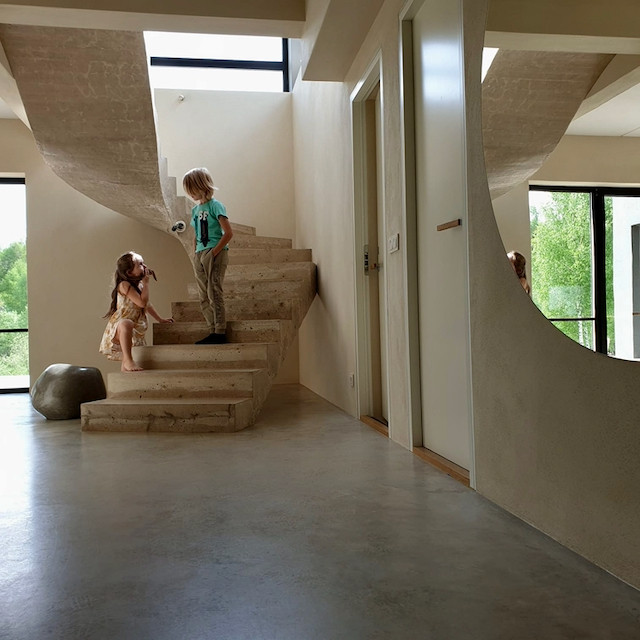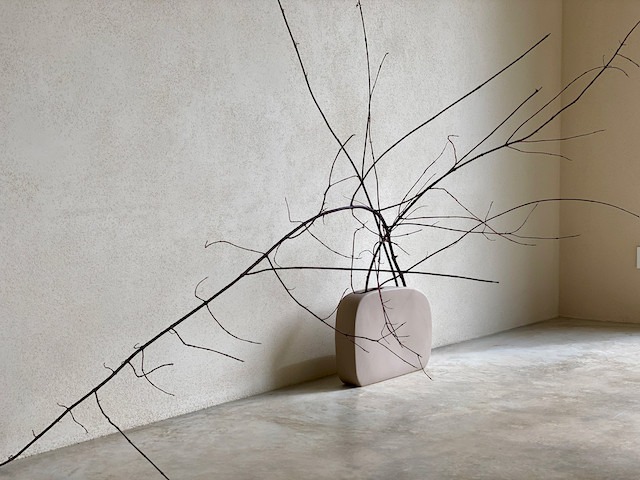Despite our best efforts as a species, nature seems to humble us with embarrassing consistency. Time and again it proves to be the superior designer when it comes to building materials. Such is the case of straw and so it is with clay.
We're not about to renounce our love for the golden insulating stalks, but we’d be remiss to neglect the seemingly miraculous properties of the latter. Natural clay plaster is a versatile alternative and performs incredibly well with straw. There are many options and many right answers. To learn everything there is to know, we set out to Estonia.
It's a little known fact, but clay products are to Estonia what cars are to Germany and watches to Switzerland. It has a rich history of clay building. We reached out to the oldest and most renowned producer in the country, Saviukumaja.
CEO Marko Kikas and his colleague Indrek Kerbo were happy to answer all our questions. Here’s everything we learned.
Estonia has a unique clay building heritage. Can you tell us a little more about it?
We have large deposits of Devon age red clay. Much of the old buildings we see in southern Estonia today were built from it. They have endured the tooth of time, and most of them stand to this day.
Back in the day, it was popular to have at least one earthen building per farm. They were used as barns, stables, houses, even saunas. The oldest ones are over 300 years old, and the last larger construction period was in the 1930s.
There is a great reference in Johannes Pertma’s book, which states that earthen buildings do not burn or rot, and are dry and warm. In barns built with clay, animals were in better health, their fur was shiny, and cows gave more milk.
There are many producers in Estonia, but Saviukumaja’s products stand out. What is your secret?
Saviukumaja is the oldest company producing natural finishing materials from clay and lime in Scandinavia and the Baltics. Our roots go back three generations.
We have many decades of experience applying clay and lime plasters. Thanks to this, we know exactly what features a high-quality finish must have. Our products are 100% pure, and the slogan - Pure Earth - states our position clearly. We are adamant about staying true to it going into the future.
Straw is an ancient building material experiencing a renaissance right now. Does clay share a similar story?
Actually, it does! Building with clay is a technology that is thousands of years old. The oldest adobe unfired bricks were found to be 8000 years old. Clay used to be — and still is today — one of the most widely used building materials.
Why did its popularity ever decline?
New materials came, and massive modernisation has become fashionable.
As a result, many building materials have become unhealthy, containing many synthetic substances. It is now increasingly understood that synthetic materials are not beneficial for human health in the long run.
Today, there is a countermovement in Western society focused on modernising historical materials. For example, adobe bricks, which were traditionally shaped by hand, are now precisely sized building blocks.
Rammed earth is no longer intended only for building barns, but is now also used for load-bearing or decorative walls in modern living. The plasters have become thinner and smoother, while being strong and durable.
People all over the world are starting to catch on, and they are becoming more conscious about their health as well as the health of their home and the planet. That is why ancient natural materials are experiencing a renaissance at the moment.
Why clay? What’s so special about this building material?
We use clay because it has many good properties, and thus it also affects mixes that are made from it. It is VOC-free, allergy-free, and does not pollute the environment. Clay plasters regulate interior air humidity and keep it at 40-60%, which is the optimal level for the human body. It helps to keep the rooms cool in the summer and warm in the winter.
Unlike other producers, we do not use pigments to tint clay plasters and paints. We have a strongly held opinion that the colour of clay is given by clay itself. If you make clay paint with white clay and add pigments and adhesives, then you have essentially made adhesive paint with a filler. Not clay paint. The same applies to clay plasters.
We also have lime-based mixtures that complement the range of natural finishing materials. They are suitable for places where clay plaster cannot cope.
How does it feel to live in a home with natural clay plaster finishes?
The shades and colours of clay itself are matte and soft, which creates a cosy and harmonious atmosphere in the home. This is a premium quality of life. Natural materials create harmony, peace, and a sense of security.
Thanks to passive humidity regulation, you do not feel stuffy or dry air. It is hard to describe but easy to perceive. People who come to visit always do.
Your products have a long journey from sitting in the earth to adorning customer’s walls. What happens in between?
At Saviukumaja we are hugely inspired by the different natural tones of clay. That is why we have a large collection of different clays from all around the world. This is our passion. It is also the reason we do not use pigments.
Typically we buy clay powder and raw clay. Raw clay is stored, air-dried, and then we grind it into clay powder ourselves. In production we mix clays with different sands according to the needs of the particular product.
To ensure the highest quality, our products are made in small quantities in a controlled and precise manner. And the results reflect this.
A large part of our products are installed on walls by top specialists in the field, both in Estonia and abroad. The goods are shipped to customers’ doorsteps all over the world. Today, we have customers in over 30 different countries.
You mentioned clay’s various colour tones. Are there different types of textures or effects that you can achieve with your plasters?
When it comes to creating different surfaces, the creativity of designers and craftsmen is the only limit.
With our products you can make finishes with a coarse structure, but also achieve a mirror-smooth surface. You can create rustic cave-like surfaces or cracked earth, the structure of dried soil, or even the mirror shine of Japanese craftsmanship.
Does clay plaster have any disadvantages? What if it gets dirty after a few years? Can it be repainted like a normal wall?
Clay plaster has no disadvantages. The question is where to use the material.
Clay plaster binds moisture in the room, but if humidity exceeds a certain limit, the plaster won't dry out. As a result, it is not suitable for basements, damp rooms and the like.
Clay plaster is also not resistant to direct contact with water and rain. Use in shower rooms and on facades that are exposed to wind and rain, is therefore questionable. Unless, of course, the surface is covered with protective layers, such as varnish, oil, or other stabilisers.
Natural clay plaster cannot be washed, so it is not suitable where it is constantly needed. Painting over with a clay paint is the easiest way to refresh a plastered surface if needed, after 10 years or more. We offer decorative colored finishing plasters, as well as clay paints made from the same clay.
What about the environmental footprint? How does clay compare to conventional finishes?
All UKU products are compostable, recyclable, and do not pose a threat to the environment.
We use solar energy, which means the energy spent on production of materials is practically non-existent when compared to cement or gypsum-based finishing materials. In fact, the energy requirements are so low, finishing materials made of clay can be called low embodied energy products.
What would your message to future homeowners be?
By choosing clay plaster and natural materials in general, you take a step closer to a better quality of life for yourself and your loved ones.
In this regard, you contribute to a sustainable living environment on planet Earth.
Thank you reading our interview.
If you are interested in natural finishing materials, head over to Saviukumaja's website.












